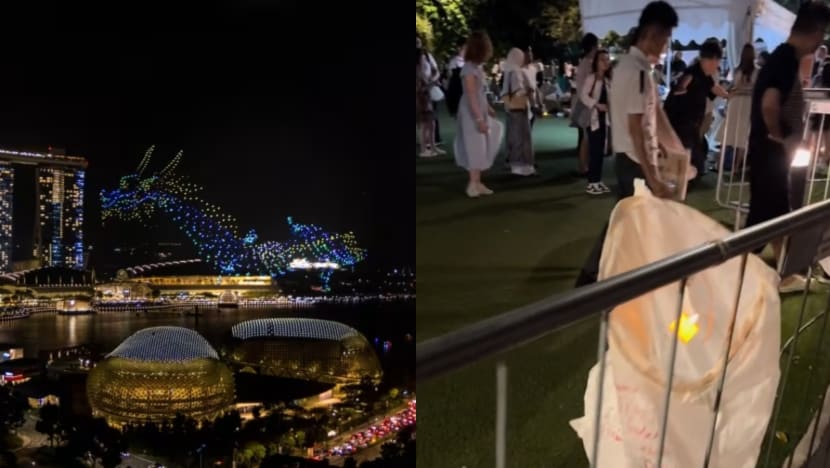Commentary: Uproar over lantern festival and drone show cancellations highlight importance of good PR
In a world where anything that goes wrong can be amplified by millions of social media users, event organisers must take the counsel of public relations professionals, says Edwin Yeo of SPRG.

The dragon drone show over Marina Bay (left) and a sky lantern tied to a barricade at Sentosa's Palawan Green on Feb 21, 2024 (right). (Images: Marina Bay Sands, TikTok/huynhthi0303)

This audio is generated by an AI tool.
SINGAPORE: The buzz phrase of the month seems to be “unforeseen circumstances”.
From the dragon drone show at Marina Bay Sands to the sky lantern festival on Sentosa, both organisers had tried to explain that the reasons for the cancellations were due to events that could not be anticipated.
Public relations folk often take this type of standard response as a means of risk management.
This usually stems from fear. Fear of financial and legal reprisals, fear of eroding relationships with stakeholders, fear of further reputation loss and also, a fear of media sensationalism and overreaction.
While some of those fears are valid, it is also time for PR to play a bigger role in decision-making, because the world has changed dramatically. Social media has enabled everyone to air their opinions, and mob mentality is more powerful today than ever in shaping public perception.
NOTHING TO SAY OR SOMETHING TO HIDE?
Ronan Keating once famously sang, “You say it best when you say nothing at all.” While the song was about how the protagonist’s gestures communicate better than words, there is also a more cynical interpretation that people tend to assume that one has something to hide. And once that is seeded into a mob mentality, it tends to stick.
In the past, when a press statement cites “unforeseen circumstances”, the public was largely dependent on the skill of the journalist to fully report what happened. If the public wasn’t satisfied by news reports, their questions were often only heard in their circles or coffee shops.
Today, the public’s questions are in full view, and these unanswered questions serve to create opinions about organisations.
Questions such as, why didn’t the event organiser for the sky lantern festival get all the necessary permits before marketing the event? How was getting necessary permits ahead of time “unforeseen”?
Why didn’t the event organiser, after conducting their failed trials, not inform ticket holders immediately that the event might not go ahead as planned and offer the option for refunds?
All these questions, when not answered, will result in the public forming the opinion that the event organiser cannot be trusted, which will then impact their ability to market more events in the future.
The impact is not limited to just the event organiser. Sentosa, for example, stated that the event was organised by a third party, for which it was the venue provider.
But questions could be asked by the public as to how Sentosa selects events for their premises. Those questions are raised because Sentosa is no ordinary venue provider, it is a national icon and a shining beacon of Singapore’s attractiveness as a tourist destination.
To protect that reputation, could Sentosa have shared why they agreed to rent the venue out to the organiser and perhaps build a narrative of their due diligence process?
INVOLVING PR PROFESSIONALS IN DECISION-MAKING
To clarify, I’m not attributing blame to the PR folks at Sentosa or even the event organisers. What they did is largely how many organisations handle their crisis communications. Indeed, you don’t know the consequences of saying things in public, and how it might be viewed by certain key stakeholders, so there is a general view that saying less is best.
Hypothetically speaking, if the event organisers were instructed to replace candles with LED lights, and this resulted in a backlash, they can’t necessarily tell the whole story publicly without incurring the wrath of the stakeholder giving the instructions.
This is why it is important to reexamine the role of PR in decision-making by organisations.
Good leaders often know how to involve PR professionals when they make decisions, and take their counsel seriously, as seriously as one would take legal counsel from a good lawyer.
Could a PR person have advised the event organiser that public announcements and ticket sales cannot commence until all approvals were obtained, or failing which, map out the different scenarios of what needs to be done if approvals were not forthcoming after ticket sales started?
Could PR have advised Sentosa’s venue rental team that there was a social media post about the same event organiser failing to deliver the event in Dubai last year? Could this not have triggered a process where the event organiser was asked to show they can successfully deliver the Sentosa event, before any decision was taken on renting out the venue to them?
That process could eventually form the backbone of a public defence for Sentosa, should things get out of hand.
The latest news is that the sky lantern festival will be rescheduled in April, but the organiser has not gotten clearance from the Singapore Civil Defence Force yet, nor will it refund attendees of the earlier event. Unsurprisingly, this sparked another round of backlash.
Following a communications playbook is not inherently wrong. But in a world where every single thing that goes wrong can be amplified by millions of social media users, leaders must adopt the mindset that PR helps not only to say the right things but also to do the right things.
The old saying goes, prevention is better than cure. That sums up how PR can and should be used in today’s world.
Edwin Yeo leads the Singapore office of SPRG, a regional integrated communications agency.




















